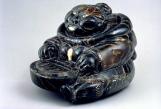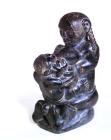1
excerpt from "Regional Diversity in Contemporary Inuit Sculpture"1990
SHOWING THE TRUTH: ILLUSTRATIVE AND NARRATIVE SCULPTURE FROM NUNAVIK
An excerpt from Regional Diversity in Contemporary Inuit Sculpture, an article written by Marie Routledge and Ingo Hessel, and published in the 1990 summer issue of Inuit Art Quarterly (IAQ), vol. 5, no. 3:12.
We carve Inuit figures because in that way we call show ourselves to the world as we were in the past and as we are now… No matter what activity the carved figure is engaged in, something about it will be true. That is because we carve to show what we have done as people. There is nothing marvellous about it. It is there for everyone to see. It is just the truth. (1)
The use of sculpture, prints or drawings to present information about traditional activities, legends or great personal events is central to contemporary Inuit art. This art, after all, is based upon one group of people giving a glimpse of itself to another. As a result, much of the sculpture produced since the 1950s is consciously narrative or illustrative in content; it aims to convey some truth or reality about Inuit culture. (2) In this context, contemporary Inuit art has today become an adjunct to the traditional practice of oral communication (singing, story-telling, etc.) and the more recent introduction of an Inuktitut writing system. And, for some contemporary artists, carving has provided a means of combining all three types of expression.
The desire to make images that are true, that deliver a message or portray an event has been a dominant force in the Inuit communities of Nunavik (Arctic Quebec). In the quest for truth, Nunavik artists have used greatly varied approaches, from a detailed, almost super-realism to more expressionistic interpretations. (3) Johnny Inukpuk, Davidialuk Alasua Amittu and Thomassie Kudluk reflect some of these stylistic variations and bring a unique vision to the task of using sculpture to convey cultural or personal truths. The notion of realism expressed by these three artists is largely conceptual, fashioned more by the mind than the eye's observation of nature. While Inukpuk concentrates on the reality of traditional activities, Davidialuk looks at the roots of Inuit history, its myths and legends. Kudluk's work is more idiosyncratic, caught up as he was in an eccentric social commentary.
Johnny Inukpuk (b. 1911) is best known for his work of the 1950s and 1960s, when he emerged as an important artist. Inukpuk's carvings are almost always illustrative of traditional domestic or hunting activities. They invariably show a figure in the act of doing something: feeding a child, cooking, blowing up an avataq (sealskin float) or wringing out a sealskin line. This concern for the details of daily life has been a trademark of sculpture from Inukpuk's community of Inukjuak since the early contemporary period. His earlier works, such as Woman and Child (1954) exhibit full, rounded, voluptuous forms that appear almost inflated, the taut outer surface seemingly wrapped around an inner core. The inlaid ivory and careful incising are accents which relieve some of this surface tension. In later works, Inukpuk paid equal attention to details such as hair and clothing, but in a more sculptural manner. In Mother Nursing Child (1962, featured on the cover of IAQ, vol. 5, no. 3), the exaggerated size of the heads and the hands (the main instruments of human action) reinforces the gestures of the woman and her child as they hold each other.
Notes
1. Paulosie Kasadlick, "Nothing Marvellous," Port Harrison/Inoucdjouac, Winnipeg: Winnipeg Art Gallery, 1977, p. 21.
2. Although the Inuit of the 1950s might have considered that their art was meant to tell only people in the South about their world, many of today's artists have also expressed the notion that they see the sculpture, prints and drawings as a legacy for their grandchildren and future generations of Inuit.
3. See George Swinton's discussion of realism in "The Povungnituk Paradox: Typically Untypical Art," Povungnituk, Winnipeg: Winnipeg Art Gallery, 1977, pp. 22-23. Another interpretation is offered by Nelson Graburn in "The Eskimos and Airport Art," Trans-Action IV No. 10 (October 1967), pp. 28-33, and "Eskimo Soapstone Carving: Innovation and Acculturation," a paper read at the 65th Annual Meeting of the American Anthropological Association, Pittsburgh, 1966.
Credits:Inuit Art Quarterly (IAQ), vol. 5, no. 3:12.

